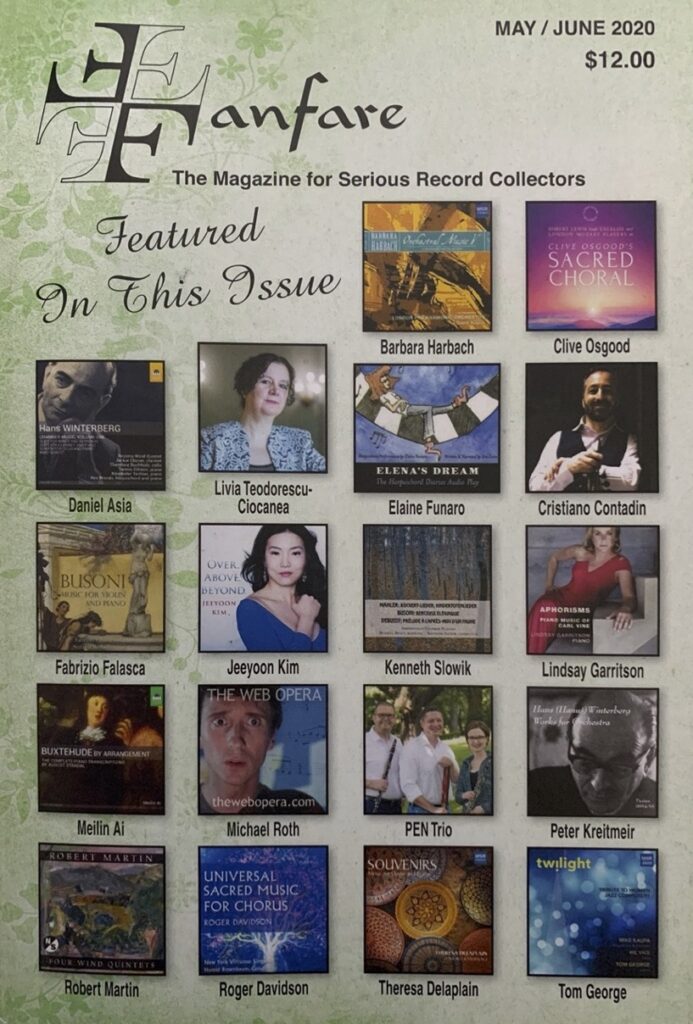FANFARE Maggio – Giugno 2020
– Intervista a Fabrizio Falasca
– Recensione del CD BUSONI Violin Sonatas & Bagatelles

Busoni – Fantasia Contradictustica by Jerry Dubins
I see by our Fanfare archive that this is your first appearance in the magazine. Since you’re new to our readers, let’s begin by having you introduce yourself. Tell us about your background and formative years. Who did you study with and where? When did you know you wanted to make the violin your life’s mission, and how did your career get started?
It’s a real pleasure for me to appear in Fanfare magazine for the first time. I began studying piano first with my sister, and then, at age 10, violin with my brother. After a couple of years, I entered the music conservatory. My main teacher in Italy was Felice Cusano, and I continued working with him for many years at the Fiesole Music School. At the same time, I also became a student of Salvatore Accardo at the Stauffer Academy in Cremona, and then I attended master classes led by Dora Schwarzberg. After my studies in Italy, I decided to move in London to continue my education, and there I studied with So-Ock Kim and graduated with a Master of Music degree in performance. My teachers also included Maxim Vengerov and Leonidas Kavakos.
[..]
With pianist Stefania Redaelli, you recently recorded an album for Brilliant Classics of works for violin and piano by Ferruccio Busoni, one of the late 19th- and early 20th-century’s true musical iconoclasts. His fascination, bordering on fixation, with Bach, always made me think of Busoni as a kind of Italian Max Reger.
[..] Busoni seems to be one of those composers whose music is talked about more than it’s actually performed or listened to, as if we need convincing that it really is important in the larger scheme of music history. So, start convincing me. How did you come to discover Busoni’s works for violin and piano? How did your interest in them evolve over time? And how would you describe them to the listener who has never heard them before?
Being from Italy, I grew up in a musical environment in which Busoni was not a real discovery, especially because he was one of the greatest piano virtuosos of the day. His fame as a pianist actually exceeded that of his recognition as a composer, at least in his lifetime. But for us Italians, with our particular tradition in bel canto, any composer who gives priority to the instrumental and not to the lyric-vocal genre, is of great interest to us. My curiosity and interest in these works came from hearing two performances of them, one by Italian violinist Franco Gulli, and the other by Gidon Kremer—both extraordinary performances that aroused in me a strong desire to learn this repertoire. And having done so, I welcomed with great joy the offer by Brilliant Classics to record these works.
To a listener who has never heard this music before, I would describe it as an intellectual and conceptual experience. In his compositions, it’s usually perceived that Busoni was also trying in some way to gain acceptance as a composer and match his reputation with that of his fame as a virtuoso pianist. All his efforts seem to go in this direction. I think that one should approach listening to his music very “seriously,” at first seeking intellectual pleasure rather than emotional involvement, which may come later.
[..]
Is this Busoni album your debut recording? If not, what else have you recorded, with whom, for what labels, and where might we find it?
This Busoni album is my debut for the Brilliant Classics label, but actually I have already recorded other CDs. My first recording was of works composed for horn, violin, and piano, and the name of the ensemble was the Dussek Trio. We did record an interesting trio by the ensemble’s namesake, Jan Vadislav Dussek, along with the famous Horn Trio, op. 40 by Brahms, Brahms for Classic Music label. Recently, too, I recorded with the legendary pianist Bruno Canino, the Franck and Beethoven “Kreutzer” Sonatas for Aulicus Classics, and for the same label, works by Chausson with my string quartet, the Philharmonia Chamber Players. A new album with Stefania Redaelli that includes a program of virtuoso pieces for violin and piano will come out very soon.
RECENSIONE del CD BUSONI Violin Sonatas: No. 1 in e, BV 234; No. 2 in e, BV 244. Bagatelles, BV 229
Fabrizio Falasca (vn); Stefania Redaelli (pn)
BRILLIANT CLASSICS
[..]
For those who have yet to make acquaintance with Busoni, Fabrizio Falasca’s recording of the composer’s earlyish violin and piano works is a perfect place to start and bound to make a very favorable impression. For those who may be familiar with works by the later Busoni, but not these works by the young and already famous colossus of the keyboard, you are sure to take pleasure in, and may well be surprised by, the Romantic beauty of this music.
I can’t say for sure if Fabrizio Falasca’s being Italian has anything to do with it, but I can say for sure that Busoni speaks to him, and through him, to us. This is gorgeous playing that brings out all of the richness and resonance of these scores. And when Busoni was writing the piano parts to these works, he surely had in mind a pianist like Stefania Redaelli who would play them. Highest recommendation.
Jerry Dubins
